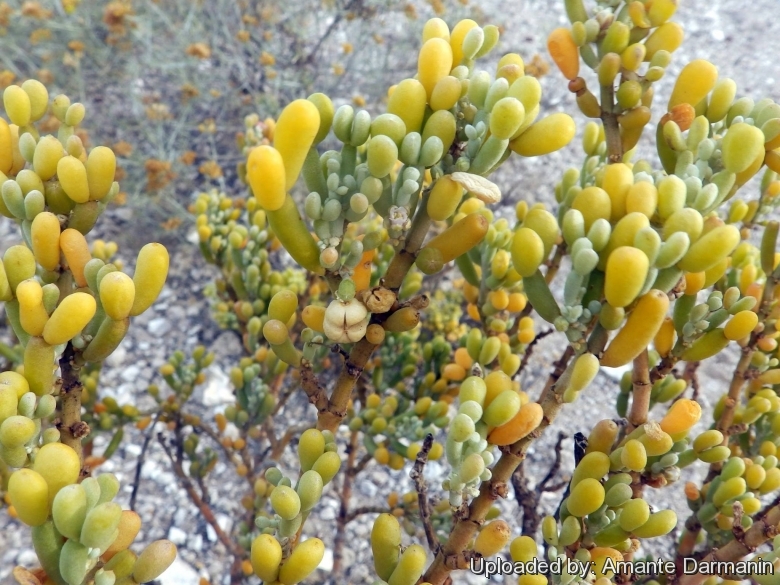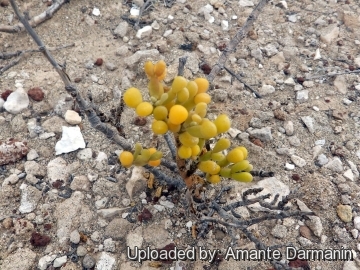Accepted Scientific Name: Tetraena fontanesii (Webb & Berthel.) Willemet & Thulin
Pl. Syst. Evol. 240(1-4): 35 (2003)

Zygophyllum fontanesii (Tetraena fontanesii) Photo by: Amante Darmanin
Growing habit at Montana Roja, Tenerife. The easiest way to describe these plants would be to say that they look like bunches of small grapes growing upwards.
Origin and Habitat: Western Sahara, Morocco, Mauritania, Senegal, Islas Selvagens, Canary Islands (Lanzarote, Fuerteventura, Gran Canaria, Tenerife, La Gomera, Hierro), Cape Verde Islands (Santo Antao Isl., Sao Vicente Isl., Ilha de Sao Nicolau, Sal Isl., Ilha da Boa Vista, Ilha de Maio, Ilha de Sao Tiago, Fogo Isl.).
Habitat and ecology: Tetraena fontanesiiSN|33711]]SN|33711]] (Zygophyllum fontanesiiSN|33712]]SN|33712]]) is a halophyte succulent plant that grows in pure sand on the dunes and on rocky soils, especially those of the northern coasts, and must be dosed regularly with salt water spray from the Atlantic Ocean. It can withstand sunlight conditions and intense drought. At times it forms local monospecific stands. This plant has the capacity to retain dunes of small size and thus contribute to the stability of the terrain.
Synonyms:
See all synonyms of Tetraena fontanesii
back
Accepted name in llifle Database:Tetraena fontanesii (Webb & Berthel.) Willemet & ThulinPl. Syst. Evol. 240(1-4): 35 (2003)Synonymy: 3
back
Common Names include:
ENGLISH: sea grape, Canarian Bean-Caper
GERMAN (Deutsch): Desfontaines' Jochblatt
SPANISH (Español): Uva de mar comun, Uvilla, Babosa, Salado baboso
Description: Tetraena fontanesiiSN|33711]]SN|33711]], best known as Zygophyllum fontanesiiSN|33712]]SN|33712]], is a an odd-appearing, bushy or cushion-like plant up to 50 cm in diameter with spreading woody branches, and thick, green or yellow leaves that looks-like small grapes growing upwards. The small, star-shaped flowers, produced in great profusion during early summer, are pale pink in colour, and are followed, later on in the season, by the rounded fruits that turn colour from green to orange. The colour and appearance of the plant, together with the brightly coloured berries gives a twofold attraction.
Leaves: Succulent powdered divided in two's, cylindrical, ovoid or club-shaped, short and flattened on the upper sides, growing upwards, shining green. The older leaves become to golden yellow to light orange, sometimes reddish in the case of plants in areas very exposed to the sun. These are borne in twos on the short stems and fall off during the resting period in winter.
Fruits (capsules): Up to 5-7 mm in diameter and can be easily confused with leaves. The ripe and dry fruits are divided into five valves.
Seeds: The seeds are very tolerant of salt water.
Bibliography: Major references and further lectures
1) Hassler M. (2017). “World Plants: Synonymic Checklists of the Vascular Plants of the World (version Nov 2016)”. In: Roskov Y., Abucay L., Orrell T., Nicolson D., Bailly N., Kirk P., Bourgoin T., DeWalt R.E., Decock W., De Wever A., Nieukerken E. van, Zarucchi J., Penev L., eds. (2017). Species 2000 & ITIS Catalogue of Life, 30th January 2017. Digital resource at www.catalogueoflife.org/col. Species 2000: Naturalis, Leiden, the Netherlands. ISSN 2405-8858.
2) Edward Johnston Alexander “Succulent Plants of New and Old World Deserts” New York Botanical Garden, 1944
3) The National Cactus and Succulent Journal: The Official Journal of the National Cactus & Succulent Society, National Cactus and Succulent Society, 1968
4) The Cactus and Succulent Journal of Great Britain, Cactus and Succulent Society of Great Britain, 1952
5) Cactaceas and succulentas mexicanas, Organo de la sociedad mexicana de cactologia, A.C. Volume XXIII, number 4, October – December 1978.
6) Hernández-Cordero, A.I.; Pérez-Chacón, E.; Hernández-Calvento, L. (2008). «Aplicación de tecnologías de la información geográfica al estudio de la vegetación en sistemas de dunas litorales. Resultados preliminares en el campo de dunas de Maspalomas (Gran Canaria, Islas Canarias).» (pdf). Tecnologías de la Información Geográfica para el Desarrollo Territorial. (Servicio de Publicaciones y Difusión Científica de la ULPGC. Las Palmas de Gran Canaria): 607, 612.
7) Hernández-Cordero, Antonio I., et al. "Proposal for new EU habitats associated with coastal dune fields of the Macaronesian region. A case study in the Canary Islands (Spain)." Journal of Coastal Conservation 19.2 (2015): 213-225.
8) Jump up ^ Lauterbach, Maximilian, et al. "Evolution of leaf anatomy in arid environments–a case study in southern African Tetraena and Roepera (Zygophyllaceae)." Molecular Phylogenetics and Evolution (2016).
9) Wikipedia contributors. "Tetraena fontanesii." Wikipedia, The Free Encyclopedia. Wikipedia, The Free Encyclopedia, 4 Jan. 2017. Web. 10 Feb. 2017.
 Tetraena fontanesii (Zygophyllum fontanesii), Montana Roja, Tenerife. With thick succulent powdered leaves divided in two's. (Tetraena fontanesii) Photo by: Amante Darmanin
Tetraena fontanesii (Zygophyllum fontanesii), Montana Roja, Tenerife. With thick succulent powdered leaves divided in two's. (Tetraena fontanesii) Photo by: Amante Darmanin Tetraena fontanesii (Zygophyllum fontanesii), Montana Roja, Tenerife. (Tetraena fontanesii) Photo by: Amante Darmanin
Tetraena fontanesii (Zygophyllum fontanesii), Montana Roja, Tenerife. (Tetraena fontanesii) Photo by: Amante DarmaninCultivation and Propagation: Tetraena fontanesiiSN|33711]]SN|33711]] is a very salt-tolerant plant which grows close to the sea in the Canary Islands. It used to be a very popular plant before the war, but it is most difficult to find in a collection today. This easy grown succulent seems to have lost favour, as so many plants do, and has had to give place to the more popular species at present in vogue. tIt is most charming, and it is remarkable that so few can be found.
Soil: The root system is very strong on mature plants and larger pots are necessary, with a rich, , well drained, gritty or sandy compost containing a fair amount of leafmould.
Exposure: Full sun throughout the year.
Overwintering: In winter keep plants slightly drier at a minimum of some 5°C.
Propagation: The propagation from seed takes rather a long time as they are slow to germinate, but cuttings may be taken in May and rooted successfully.












